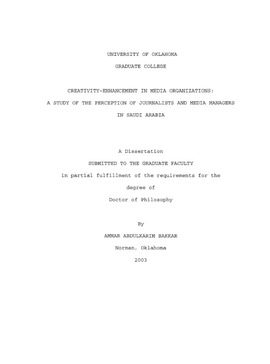| dc.contributor.advisor | VanGundy, Arthur, | en_US |
| dc.contributor.author | Bakkar, Ammar Abdulkarim. | en_US |
| dc.date.accessioned | 2013-08-16T12:19:08Z | |
| dc.date.available | 2013-08-16T12:19:08Z | |
| dc.date.issued | 2003 | en_US |
| dc.identifier.uri | https://hdl.handle.net/11244/656 | |
| dc.description.abstract | This dissertation examines creativity enhancement in the context of media organizations in Saudi Arabia. In the empirical component of this study, managers and employees in seven Saudi media organizations were surveyed for their perceptions of creative climates in media organizations. The Situational Outlook Questionnaire (SOQ) was used as an instrument to collect the study data. The questionnaire explores nine dimensions of the organizational creative climate. A total of 209 participants (43 managers and 166 employees) responded to the SOQ by answering 53 questions about their assessments of the organizational climate. They also answered general demographic questions, and three open-ended narrative questions. Research questions focus on describing how managers and employees in Saudi organizations perceive the climate in their organizations. In addition, the research questions stress the effect of demographic factors on the participants' perception, and the differences between managers and employees. Statistical tests show that gender is a significant factor in defining differences between managers and employees in perceiving creative climate, especially regarding challenge, trust, and freedom dimension of the SOQ. This finding reflects a unique situation for gender in Saudi media organizations. When comparing their perceptions to those reported in other international organizations, managers and employees in Saudi media organizations report significantly lower levels of challenge, risk-taking, idea support, freedom, playfulness/humor, and trust/openness on the SOQ, and significantly higher levels of conflict. Employees, and not managers, reported significantly low levels of debate. Differences between males and females, as well as managers and employees on these dimensions are explained in terms of the situation of Saudi media organizations. The study conducts an extensive literature review of factors that lead to creative climates in organizations in order to introduce a model of making of a creative organization. This model includes three major factors: (a) the management system of the organization, (b) daily work activities, and (c) organizational life. These factors are connected to a specific degree of creativity needed for an organization, based on the special nature of the organization. An explanation of the model's strengths and weaknesses is offered. | en_US |
| dc.format.extent | xi, 215 leaves : | en_US |
| dc.subject | Creativity. | en_US |
| dc.subject | Mass media Saudi Arabia. | en_US |
| dc.subject | Speech Communication. | en_US |
| dc.subject | Journalism. | en_US |
| dc.subject | Business Administration, Management. | en_US |
| dc.subject | Press Saudi Arabia. | en_US |
| dc.title | Creativity-enhancement in media organizations: A study of the perception of journalists and media managers in Saudi Arabia. | en_US |
| dc.type | Thesis | en_US |
| dc.thesis.degree | Ph.D. | en_US |
| dc.thesis.degreeDiscipline | Department of Communication | en_US |
| dc.note | Source: Dissertation Abstracts International, Volume: 64-09, Section: A, page: 3365. | en_US |
| dc.note | Adviser: Arthur VanGundy. | en_US |
| ou.identifier | (UMI)AAI3107296 | en_US |
| ou.group | College of Arts and Sciences::Department of Communication | |
